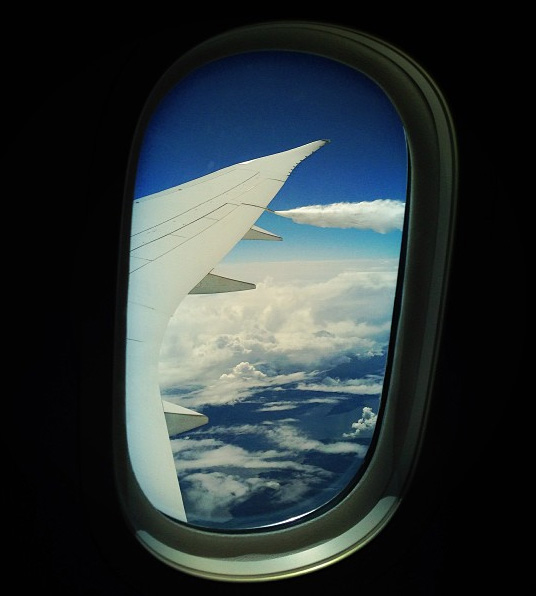
Photo of the fuel being dumped mid-flight from United flight 139. Photo by Chris Seewald.
A United Airlines Boeing 787 Dreamliner (Flight 139) from Denver to Narita, Tokyo made an emergency landing today at Seattle-Tacoma International Airport (SEA) at about 4:15pm PST. The aircraft was met by fire crew, was inspected and allowed to park at the A-concourse. Fire crews determined the aircraft was safe and mechanics are in the process of repairing the aircraft after there was a reported issue with the oil filter.
“United flight 139 from Denver to Tokyo-Narita diverted to Seattle due to an indication of a problem with an oil filter,” stated an airline spokesperson via email. “The aircraft landed normally and without incident and we are working to reaccommodate customers.”
A photo taken from one of the passengers on the flight, Chris Seewald, was able to capture the Dreamliner dumping fuel before landing, which is standard procedure. Multiple reports from the ground show that United will be bringing in a replacement aircraft tonight and passengers will continue their flight to Japan tomorrow morning.
Although this is a minor issue and airline diversions are made all the time, unfortunately, the world is currently watching the 787 Dreamliner closely. It seems that this incident shows more of the power of social media and sharing experiences almost in a live fashion than it does about safety/mechanical concerns of the 787 Dreamliner.

The United Airlines Boeing 787 Dreamliner (N26906) involved in the emergency landing taken in November 2012. Photo by Andrew W. Sieber / Flickr CC.

The Boeing 787-10 seen in Dreamliner livery. Composite image from Boeing.
At the Paris Air Show today, Boeing officially launched the longer version of the Boeing Dreamliner: the 787-10. According to Boeing, “Customer launch commitments for the 787-10 include Air Lease Corporation, with 30 airplanes; GE Capital Aviation Services, with 10; International Airlines Group / British Airways, with 12 subject to shareholder approval; Singapore Airlines, with 30 and United Airlines, with 20 airplanes.”
BONUS: Video animation of the Boeing 787-10 Dreamliner
The 787-10 becomes the largest of the Dreamliner family with an additional 20 foot stretch over the 787-9, seating for 300-330 passengers and the ability to fly up to 7,000 nautical miles. The new model is slated to complete final assembly and test flights in 2017 with first delivery in 2018.

United shows off their new uniforms in Chicago. Image from United.
This story was written by Christopher L. McMullin (@787forlife) for AirlineReporter.com:
The world’s largest airline (based on scheduled passenger-kilometers flown) has recently changed up their employee couture. May 21, 2013 marked United Airline’s 25th anniversary at Newark’s Liberty International Airport (EWR) and felt it would make a great backdrop to show off their new uniforms.
United is the largest airline in the New York area and currently the sole tenant of Newark’s terminal C and the airport serves as their third-largest U.S. Hub. They have more than 13,000 local employees and offer more flights & seats from the region to more world-wide gateways than any other airline in history. Currently, United offers more than 400 flights daily from Newark.

A United Boeing 787 Dreamliner. Photo by Jack Harty / Airchive.com.
An excerpt from Jack Harty’s story on Airchive.com:
More than one hundred days after the FAA grounded the 787, United Airlines flew their first post-grounding 787 flight from Houston to Chicago on May 20. More than 200 passengers, including executives from both Boeing and United, made history as they spent part of their day cruising at 41,000 feet and at a Mach speed of 0.85 on United flight 1 to mark the return of United’s Dreamliners.
On September 22, 2012, United Airlines quietly took delivery of their first Boeing 787 Dreamliner, and, six days later, they ferried it to Houston, Texas where a large crowd of employees and local journalists joined to celebrate United’s dream come true.
However, United still had to receive certification from the FAA to fly passengers. It was a long five weeks for United as they conducted safety drills, practiced aircraft servicing, and flew several proving runs to Amsterdam, Chicago, Denver, Los Angeles, Newark, San Francisco, and Tokyo. United’s second 787 was delivered on October 31 which was several days late as Boeing experienced delays. United had to scrub several 787 flights due to the delay.
Continue reading United Airlines Re-Inaugurates 787 Dreamliner Flights on Airchive.com

United Airlines First Boeing 787 on Launch Day at the Boeing Factory in Everett. Phone: Mal Muir airlinereporter.com
Recently United Airlines decided to increase their change fee on all domestic bookings from $150 to $200 per person. US Airways followed suit shortly after. Eventually Delta & American matched. With those change fees in mind, it got me thinking, “where is the spectrum of these fees in the US right now?”
Before we look at all the change fees each airline charges, we first need to look at what a change fee is and why airlines charge them. A ’œChange Fee’ to the airlines is a fee that is charged when you need to change the date or time on your flight booking. On heavily discounted airfares, changes are restricted so that you can be given the cheapest price possible. At least’¦ that’s the idea. In essence this is a fee charged by the airline, as a penalty to you for changing your mind.
Changing the airfare on the airline’s end probably doesn’t cost them much, if anything. In this day and age of overselling most flights, the airline has probably already sold it within seconds of your change.





